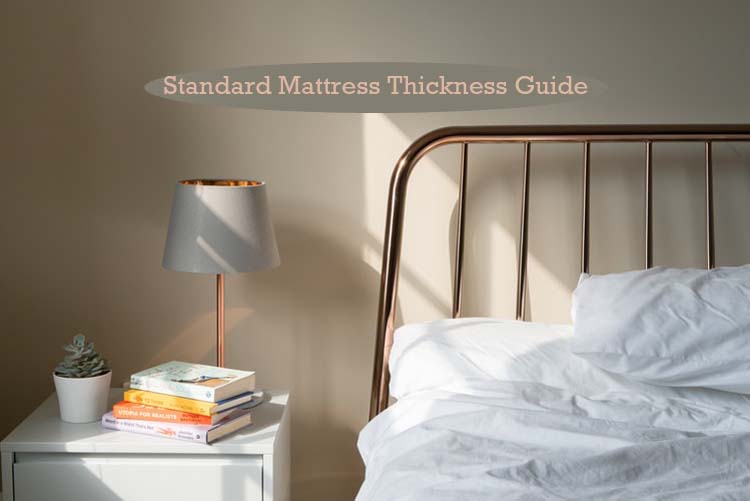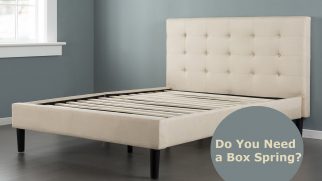Standard Mattress Thickness Guide
by | Last UpdatedSince a mattress is the main item in your bedroom, you need to consider lots of details before choosing the right one.
One of them is thickness.
How thick is enough? Do you need a high-profile mattress, or the thinner the better?
I will help you answer this question in this comprehensive mattress thickness guide!

How Thick Should a Mattress Be?
Let me confess first:
In articles like these, I really like other users’ input.
That’s why I’ve created a poll on my Facebook page and asked my followers how thick their mattress is. 243 people responded to it, and here are the results:
- 2-5 inches: 32 (13.17%)

- 5-8 inches: 40 (16.46%)
- 8-12 inches: 101 (41.57%)
- 12-15 inches: 61 (25.1%)
- 15+ inches: 9 (3.7%)
So, apparently, there’s no standard mattress thickness that would suit everyone.
And yet, there are general guidelines that vary for different types of mattresses, and I will list them below:
- Memory foam. There are 5-inch and even 6-inch thick memory foam beds on the market, but I genuinely recommend that you avoid them if you can afford other options. Low-profile memory foam beds may offer insufficient sinkage, especially if you’re a heavier sleeper. Plus, they tend to be very firm and might go flat sooner. The optimal thickness for a memory foam mattress — assuming it has a couple of comfort layers on top of a sturdy base — varies from 8 to 13 inches, so focus your search on this range.
- Hybrid. Hybrid mattresses have a coil system, which measures about 7 inches on average. Then, there are at least three upper layers made of foam, latex, wool, or fiber. Also, there might be a thin foam base under the coils, to absorb motion. Thus, you get a mattress starting at 12 inches thick. Even though some low-profile hybrid options do exist, they might be less durable and lack comfort.
- Innerspring. Typical innerspring construction offers you a coil block and 1-2 comfort layers above, so these beds don’t exceed 12 inches. 8-inch and 10-inch thick innerspring mattresses are the most common on the market and could make a good purchase for you if you don’t mind their firmness, which typically reaches 8-9 points out of 10.
- Latex. Latex mattresses usually vary in height from 9 to 13 inches. Since latex is the most expensive material for making mattresses you can get, 9-inch and 10-inch models are the most common ones. I personally am a big fan of latex (its natural form, to be precise), so I would gladly sleep on a latex mattress regardless of its thickness.
“A thinner mattress can be suitable for kids and petite sleepers. They have smaller weight and don’t sink too deep into the mattress, so there’s little chance they will feel the slats or the floor underneath the mattress, unlike larger sleepers who are more to face this issue.”
What to Expect From Different Mattress Heights?
Now, let me break down the ranges of mattress thickness and point out some issues you might face with beds within each range.
2-5 Inches (Low-Profile Mattresses)
It’s fair to say that such mattresses aren’t designed for adults to sleep on them regularly.
The only exception is futon mattresses, which usually measure 3-5 inches and are perfect for those who practice sleeping on the floor.
Other than futons, low-profile models may be used for cribs, bunk beds, and RV beds.
The main problem with these mattresses is that they might be uncomfortable even for an average-weight adult, let alone overweight sleepers. Without a proper base or additional mattress topper, chances are that you will wake up sore instead of having refreshing sleep. Especially if you’re used to sleeping on thicker beds.
“Thinner mattresses use less material, so their prices are usually lower compared to thicker models. That’s why they can make a great pick for occasional use, e.g. as a guest bed.”
5-8 Inches (Slim or Thin Mattresses)
Now, these are still low-profile, but adding just a couple of inches more makes a drastic difference in comfort. With a slim mattress, you can expect at least one comfort layer on top of the core, which might be enough to cradle you if you’re a petite individual or sleep on your stomach/back.
Also, slim mattresses tend to be firmer and won’t make you stuck in their layers, which might be a plus for people who have mobility issues.
8-12 Inches (Standard Mattresses)
This is the range we mean when referring to a standard mattress thickness. Most mattresses on the market measure 8-12 inches, and it’s not surprising:
My survey showed that it’s the most preferred thickness, so there’s demand for it.
Interestingly, even a small change in height for mattresses in this category might make you love or hate the bed. For example, if you compare a 10-inch and a 12-inch thick mattress, chances are the latter will feel way more comfortable.
“Mattress thickness is very tricky. Although there’s this tendency that thicker beds offer more comfort, it’s not true for every single model. And for every single sleeper, too, as we all have a different understanding of comfort.”
Now, given the popularity of this range of thickness, you will be able to find a mattress of any firmness, size, and type here. So, regardless of your sleeping style, weight, and preferences, it will be easy to find a perfect fit among 8-12-inch beds.
12-15 Inches (Medium-to-Thick Mattresses)
Most mattresses in this category are either hybrids or foam beds with a lot of comfort layers. Even though excess thickness might improve durability, when it comes to comfort, these mattresses might be only slightly better than those from the previous range. That’s because your body needs the same amount of cushioning materials to feel relaxed, so there’s no need to stack up the layers.
Thicker mattresses are often viewed as looking luxurious, so if that’s what you’re after, you can upgrade your luxurious bedroom with a 15-inch model.
But there’s one thing you should note:
A thicker mattress requires a low-profile frame.
If you pair it with a high-profile frame — and, heaven forbid, a box spring — you may end up with a very high bed, which you will literally have to climb onto.
Higher Than 15 Inches (Very Thick Mattresses)
Mattresses that thick aren’t very common on the market, as there’s little demand. And I’ve just stated above the most probable reason for that:
They are awkwardly high. And it might be not easy to find a suitable low-profile foundation to support such as large and heavy mattress.
Still, some people choose them. Actually, they may work pretty well if you put them directly on the floor.
Note, though, that the higher the mattress, the higher the price.
Choosing the Right Mattress Thickness for Your Needs
In the last part of this mattress thickness guide, I want to suggest different scenarios for you and give some general recommendations on choosing the right mattress height.
If you’re a large sleeper…
Heavy sleepers need more cushioning to support the load of their body, so they should choose thicker mattresses. Here are some detailed guidelines based on your weight:
- 250 pounds or less: try using at least a 10-inch thick mattress. It should be capable of giving you enough comfort throughout its lifespan without sagging.
- 250-275 pounds: thicker models measuring 11-12 inches may be optimal in this case.
- 275 pounds and more: start at 13-14 inches thick and give your preference to latex or hybrid models, as they are less prone to sagging.
If you’re choosing a bed for a heavy couple, it’s better to consider the weight and sleeping style of both individuals separately and go for a split mattress design.
Also, you can check my guide on mattresses for heavy sleepers with detailed reviews and specific recommendations.
If you’re struggling with aches and pains…
Things might get a bit trickier here because people with different health conditions need mattresses with a different feel, and thickness is one of the factors that impact the feel.
For instance, back pain sufferers might need a firmer mattress with fewer comfort layers for enhanced spine support, so thinner models could suit them better.
If you need a mattress for an individual with hip pain, then you might opt for a thicker option, for mode cradling and pressure relief in these areas.
Also read: The 8 Best Mattresses For Lower Back Pain Sufferers In 2020 – Buyer’s Guide And Reviews
Best Mattresses For Arthritis And Fibromyalgia Sufferers: Have The Pain-Free Sleep Every Night
If you have limited mobility…
Individuals who use wheelchairs or other mobility devices might have specific mattress height requirements. For example, they should able to easily transfer from the wheelchair to the bed and back, or move along the mattress surface without any efforts.
The best choice for this scenario would be a firmer mattress without a quilted pillow top. It should be neither too high nor too low, as any of these extremes can create difficulties. 10-12 inches may be just right.
So, you now have a better understanding of mattress thickness and how to choose it correctly. How high is your current mattress? What kind of mattress support do you use with it and how does it affect its height? Let us know in the comments!





No Comments